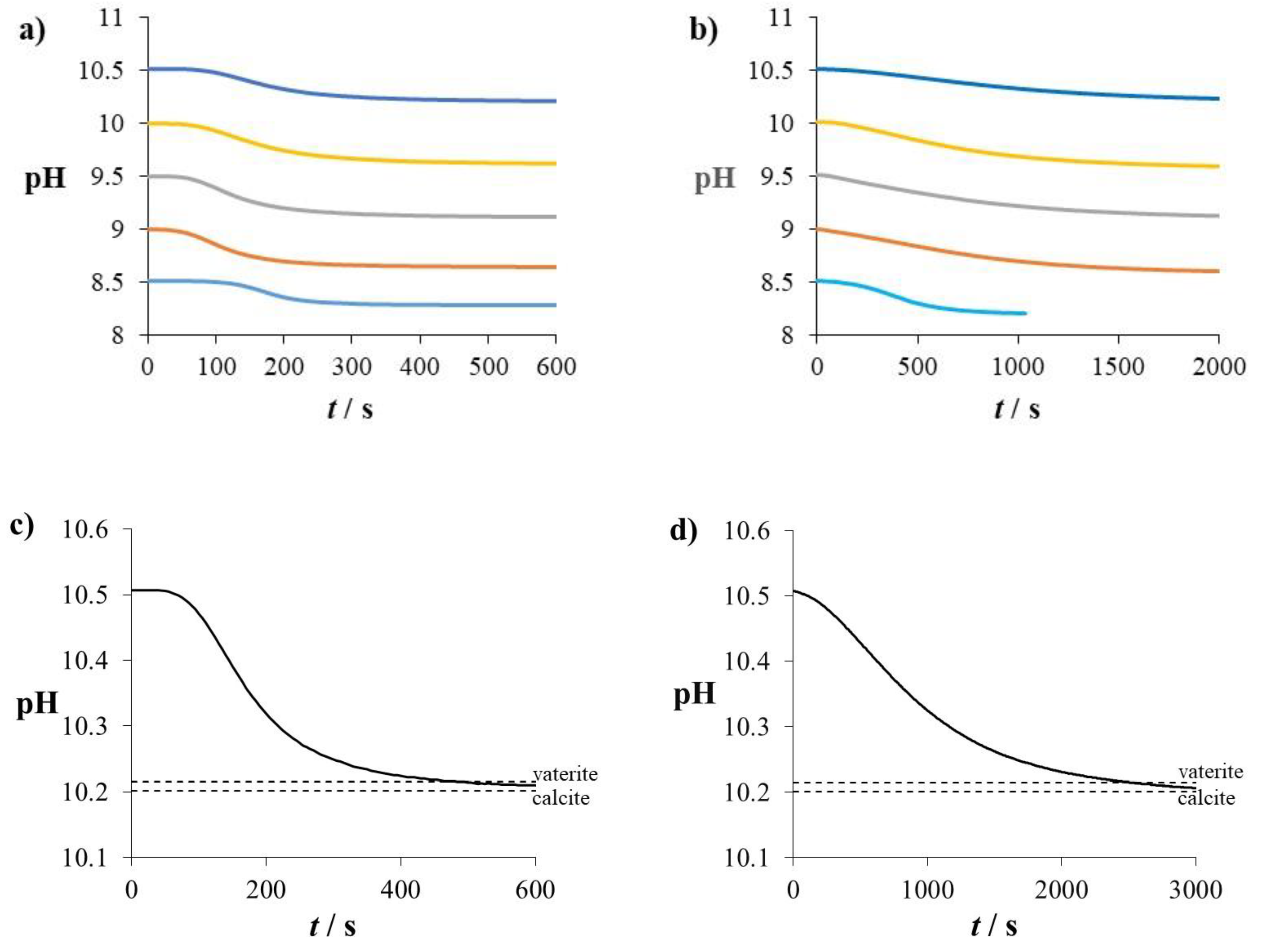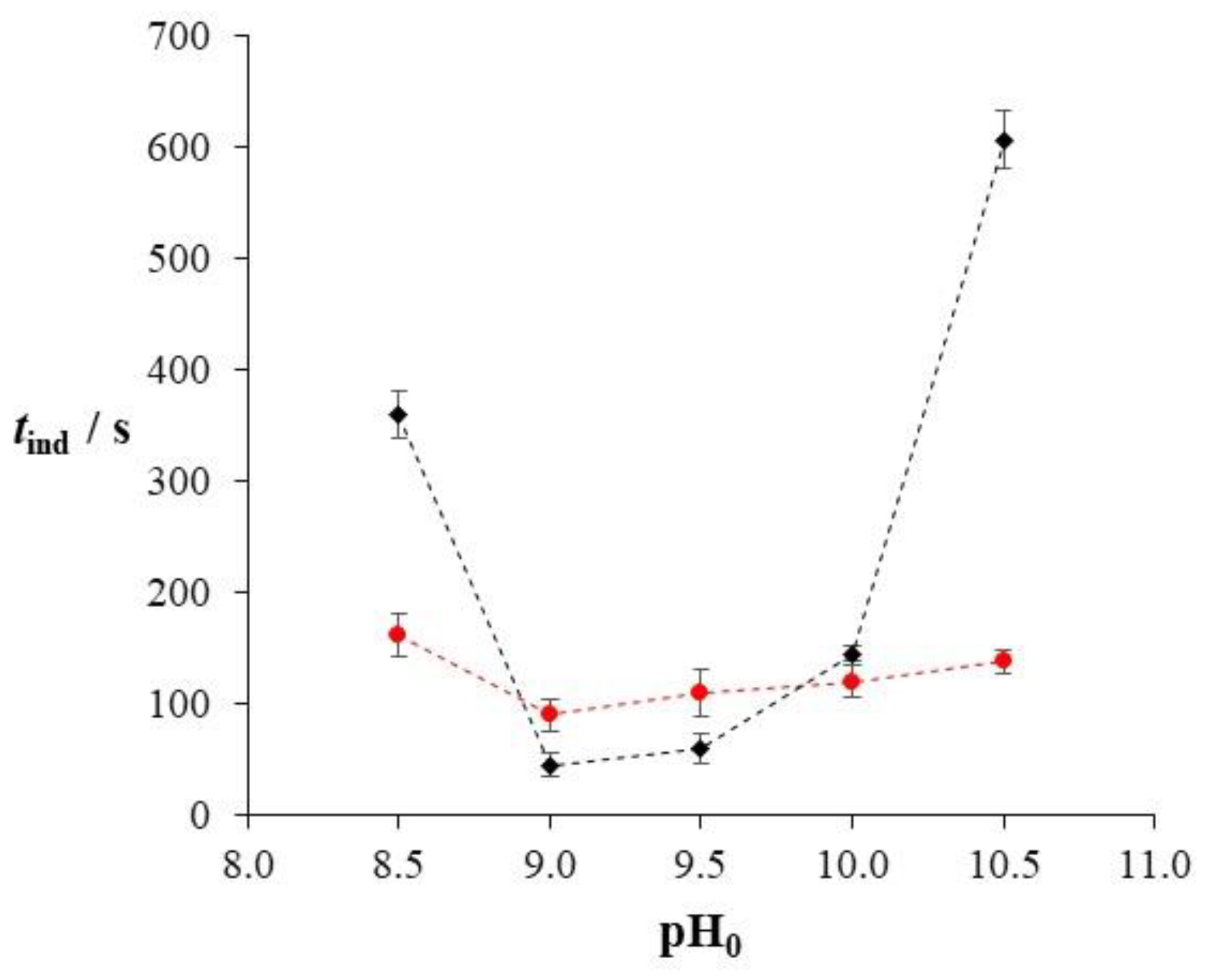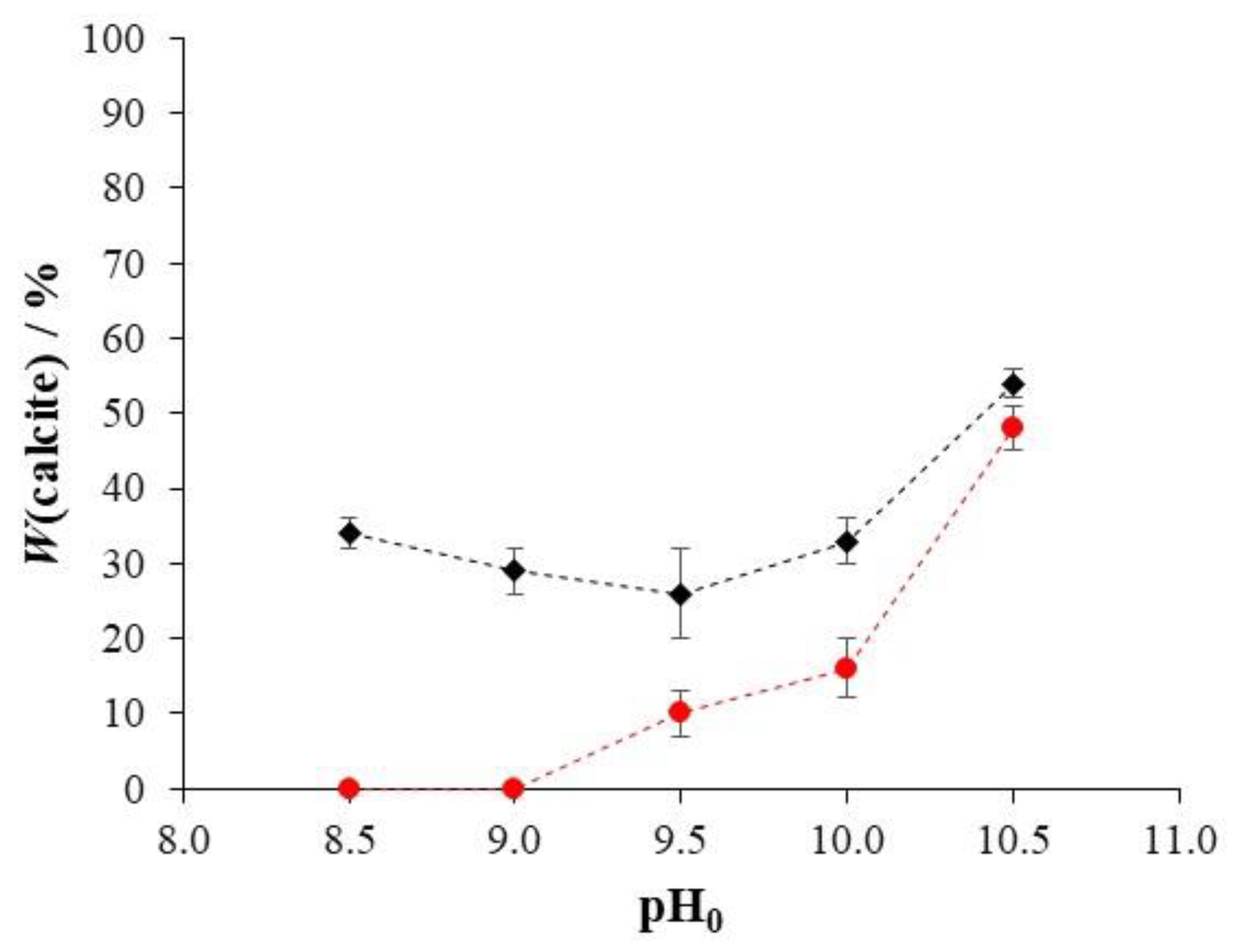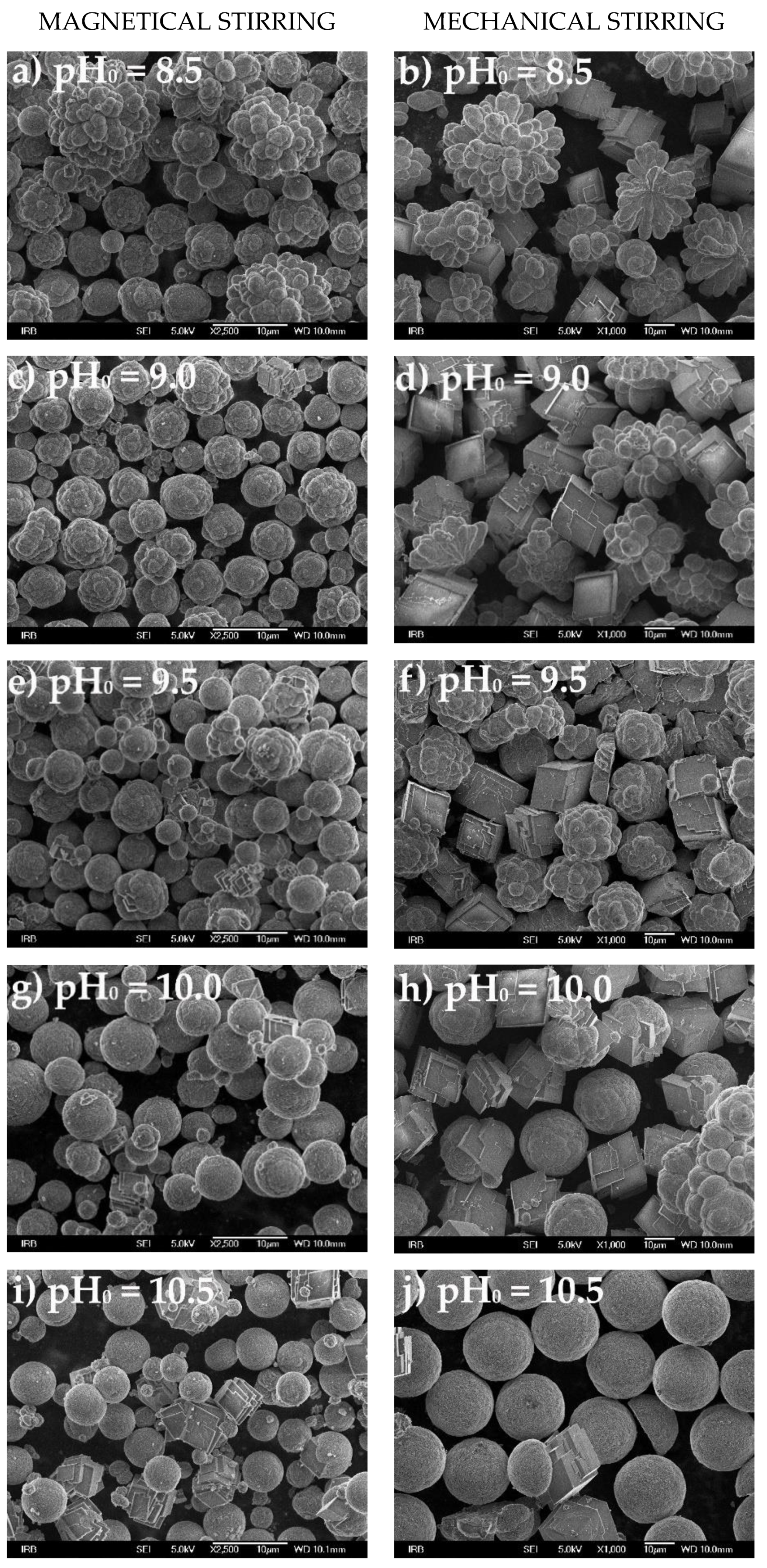Effect of pH and Type of Stirring on the Spontaneous Precipitation of CaCO3 at Identical Initial Supersaturation, Ionic Strength and a(Ca2+)/a(CO32−) Ratio
Abstract
:1. Introduction
2. Materials and Methods
2.1. Materials
2.2. Precipitation Experiments
2.3. Characterization of Precipitate
2.4. Data Analyses
3. Results and Discussion
3.1. Precipitation Kinetics
3.2. Polymorphism
3.3. Particle Size
3.4. Morphology of Precipitated CaCO3
4. Conclusions
- Induction time of CaCO3 spontaneous precipitation in magnetically and mechanically stirred systems depends on initial pH and type of stirring. The effects of pH on induction time were more pronounced in mechanically stirred systems.
- The increase of initial pH favours the formation of calcite no matter the type of stirring. Concurrently, comparison of samples isolated from the systems with the same initial pH, but different type of stirring, showed that mass fraction of calcite was higher in the samples isolated from the systems that were mechanically stirred. This leads to the conclusion that magnetical stirring favours formation of vaterite while mechanical stirring favours formation of calcite.
- Size of crystals depends on the type of stirring used; both calcite and vaterite crystals were larger in the mechanically stirred systems than the crystals isolated from the magnetically stirred systems.
- Type of stirring did not influence the morphology of precipitated CaCO3 crystals. The main factor contributing to the change of morphology was pH. Morphology of calcite crystals did not significantly change with the increase of pH (calcite remained in the form of rhombohedra), but by increasing pH the morphology of the vaterite crystals changed from cauliflower-like spheroids to regular spherulites.
Supplementary Materials
Author Contributions
Funding
Institutional Review Board Statement
Informed Consent Statement
Data Availability Statement
Acknowledgments
Conflicts of Interest
References
- Checa, A.G. Physical and biological determinants of the fabrication of Molluscan shell microstructures. Front. Mar. Sci. 2018, 5, 353. [Google Scholar] [CrossRef] [Green Version]
- Veron, J.E.N. Corals: Biology, Skeletal Deposition, and Reef-Building. In Encyclopedia of Modern Coral Reefs; Hopley, D., Ed.; Encyclopedia of Earth Sciences; Springer: Dordrecht, The Netherlands, 2011; pp. 275–281. [Google Scholar]
- Uriz, M.J. Mineral skeletogenesis in sponges. Can. J. Zool. 2006, 84, 322–356. [Google Scholar] [CrossRef]
- Jacob, D.E.; Wirth, R.; Agbaje, O.B.A.; Branson, O.; Eggins, S.M. Planktic foraminifera form their shells via metastable carbonate phases. Nat. Commun. 2017, 8, 1265. [Google Scholar] [CrossRef] [Green Version]
- Mann, S. Biomineralization: Principles and Concepts in Bioinorganic Materials Chemistry; Oxford University Press: New York, NY, USA, 2001; ISBN 0198508824. [Google Scholar]
- Carlson, C.A.; Bates, N.R.; Hansell, D.A.; Steinberg, D.K. Carbon Cycle. In Encyclopedia of Ocean Sciences; Elsevier: Amsterdam, The Netherlands, 2001; pp. 390–400. [Google Scholar]
- Njegić-Džakula, B.; Brečević, L.; Falini, G.; Kralj, D. Calcite Crystal Growth Kinetics in the Presence of Charged Synthetic Polypeptides. Cryst. Growth Des. 2009, 9, 2425–2434. [Google Scholar] [CrossRef]
- Brečević, L.; Nöthig-Laslo, V.; Kralj, D.; Popović, S. Effect of divalent cations on the formation and structure of calcium carbonate polymorphs. J. Chem. Soc. Faraday Trans. 1996, 92, 1017–1022. [Google Scholar] [CrossRef]
- Jie, P.; Zhiming, L. Influence of temperature on microbially induced calcium carbonate precipitation for soil treatment. PLoS ONE 2019, 14, e0218396. [Google Scholar]
- Ruiz-Agudo, E.; Putnis, C.V.; Rodriguez-Navarro, C.; Putnis, A. Effect of pH on calcite growth at constant aCa2+/aCO32− ratio and supersaturation. Geochim. Cosmochim. Acta 2011, 75, 284–296. [Google Scholar] [CrossRef]
- Zuddas, P.; Mucci, A. Kinetics of Calcite Precipitation from Seawater: II. The Influence of the Ionic Strength. Geochim. Cosmochim. Acta 1998, 62, 757–766. [Google Scholar] [CrossRef]
- Kralj, D.; Brečević, L.; Nielsen, A.E. Vaterite growth and dissolution in aqueous solution I. Kinetics of crystal growth. J. Cryst. Growth 1990, 104, 793–800. [Google Scholar] [CrossRef]
- Doney, S.C.; Fabry, V.J.; Feely, R.A.; Kleypas, J.A. Ocean Acidification: The Other CO2 Problem. Ann. Rev. Mar. Sci. 2009, 1, 169–192. [Google Scholar] [CrossRef] [PubMed] [Green Version]
- Feely, R.A.; Doney, S.C.; Cooley, S.R. Ocean Acidification: Present Conditions and Future Changes in a High-CO2 World. Oceanography 2009, 22, 36–47. [Google Scholar] [CrossRef] [Green Version]
- Tans, P. An Accounting of the Observed Increase in Oceanic and Atmospheric CO2 and the Outlook for the Future. Oceanography 2009, 22, 26–35. [Google Scholar] [CrossRef] [Green Version]
- Key, R.M.; Kozyr, A.; Sabine, C.L.; Lee, K.; Wanninkhof, R.; Bullister, J.L.; Feely, R.A.; Millero, F.J.; Mordy, C.; Peng, T.-H. A global ocean carbon climatology: Results from Global Data Analysis Project (GLODAP). Global Biogeochem. Cycles 2004, 18, GB4031. [Google Scholar] [CrossRef]
- Kroeker, K.J.; Kordas, R.L.; Crim, R.N.; Singh, G.G. Meta-analysis reveals negative yet variable effects of ocean acidification on marine organisms. Ecol. Lett. 2010, 13, 1419–1434. [Google Scholar] [CrossRef] [PubMed]
- Gazeau, F.; Quiblier, C.; Jansen, J.M.; Gattuso, J.-P.; Middelburg, J.J.; Heip, C.H.R. Impact of elevated CO2 on shellfish calcification. Geophys. Res. Lett. 2007, 34, L07603. [Google Scholar] [CrossRef] [Green Version]
- Ries, J.B. A physicochemical framework for interpreting the biological calcification response to CO2-induced ocean acidification. Geochim. Cosmochim. Acta 2011, 75, 4053–4064. [Google Scholar] [CrossRef]
- McConnaughey, T.A.; Gillikin, D.P. Carbon isotopes in mollusk shell carbonates. Geo-Mar. Lett. 2008, 28, 287–299. [Google Scholar] [CrossRef]
- Kubota, K.; Yokoyama, Y.; Ishikawa, T.; Suzuki, A.; Ishii, M. Rapid decline in pH of coral calcification fluid due to incorporation of anthropogenic CO2. Sci. Rep. 2017, 7, 7694. [Google Scholar] [CrossRef] [Green Version]
- Comeau, S.; Tambutté, E.; Carpenter, R.C.; Edmunds, P.J.; Evensen, N.R.; Allemand, D.; Ferrier-Pagès, C.; Tambutté, S.; Venn, A.A. Coral calcifying fluid pH is modulated by seawater carbonate chemistry not solely seawater pH. Proc. R. Soc. B Biol. Sci. 2017, 284, 20161669. [Google Scholar] [CrossRef]
- Korchef, A.; Touaibi, M. Effect of pH and temperature on calcium carbonate precipitation by CO2 removal from iron-rich water. Water Environ. J. 2020, 34, 331–341. [Google Scholar] [CrossRef]
- Rodriguez-Blanco, J.D.; Shaw, S.; Bots, P.; Roncal-Herrero, T.; Benning, L.G. The role of pH and Mg on the stability and crystallization of amorphous calcium carbonate. J. Alloys Compd. 2012, 536 (Suppl. S1), S477–S479. [Google Scholar] [CrossRef]
- Zhou, G.-T.; Yao, Q.-Z.; Fu, S.-Q.; Guan, Y.-B. Controlled crystallization of unstable vaterite with distinct morphologies and their polymorphic transition to stable calcite. Eur. J. Mineral. 2010, 22, 259–269. [Google Scholar] [CrossRef] [Green Version]
- Tobler, D.J.; Rodriguez Blanco, J.D.; Sørensen, H.O.; Stipp, S.L.S.; Dideriksen, K. Effect of pH on Amorphous Calcium Carbonate Structure and Transformation. Cryst. Growth Des. 2016, 16, 4500–4508. [Google Scholar] [CrossRef]
- Buljan Meić, I.; Kontrec, J.; Domazet Jurašin, D.; Njegić Džakula, B.; Štajner, L.; Lyons, D.M.; Dutour Sikirić, M.; Kralj, D. Comparative Study of Calcium Carbonates and Calcium Phosphates Precipitation in Model Systems Mimicking the Inorganic Environment for Biomineralization. Cryst. Growth Des. 2017, 17, 1103–1117. [Google Scholar] [CrossRef]
- Njegić-Džakula, B.; Falini, G.; Brečević, L.; Skoko, Ž.; Kralj, D. Effects of initial supersaturation on spontaneous precipitation of calcium carbonate in the presence of charged poly-l-amino acids. J. Colloid Interface Sci. 2010, 343, 553–563. [Google Scholar] [CrossRef] [PubMed]
- Mlinarić, N.M.; Kontrec, J.; Džakula, B.N.; Falini, G.; Kralj, D. Role of hydrodynamics, li+ addition and transformation kinetics on the formation of plate-like {001} calcite crystals. Crystals 2021, 11, 250. [Google Scholar] [CrossRef]
- Davis, C.W. Ion Association; Butterworths: London, UK, 1962. [Google Scholar]
- Kralj, D.; Brečević, L.; Kontrec, J. Vaterite growth and dissolution in aqueous solution III. Kinetics of transformation. J. Cryst. Growth 1997, 177, 248–257. [Google Scholar] [CrossRef]
- Kralj, D.; Brečević, L.; Nielsen, A.E. Vaterite growth and dissolution in aqueous solution II. Kinetics of dissolution. J. Cryst. Growth 1994, 143, 269–276. [Google Scholar] [CrossRef]
- Brečević, L.; Kralj, D.; Garside, J. Factors influencing the distribution of hydrates in calcium oxalate precipitation. J. Cryst. Growth 1989, 97, 460–468. [Google Scholar] [CrossRef]
- Andreassen, J.P.; Hounslow, M.J. Growth and aggregation of vaterite in seeded-batch experiments. AIChE J. 2004, 50, 2772–2782. [Google Scholar] [CrossRef]
- Nehrke, G.; Van Cappellen, P. Framboidal vaterite aggregates and their transformation into calcite: A morphological study. J. Cryst. Growth 2006, 287, 528–530. [Google Scholar] [CrossRef]
- Andreassen, J.-P. Formation mechanism and morphology in precipitation of vaterite—Nano-aggregation or crystal growth? J. Cryst. Growth 2005, 274, 256–264. [Google Scholar] [CrossRef]
- Meldrum, F.C.; Cölfen, H. Controlling Mineral Morphologies and Structures in Biological and Synthetic Systems. Chem. Rev. 2008, 108, 4332–4432. [Google Scholar] [CrossRef] [PubMed]
- Andreassen, J.P.; Beck, R.; Nergaard, M. Biomimetic type morphologies of calcium carbonate grown in absence of additives. Faraday Discuss. 2012, 159, 247–261. [Google Scholar] [CrossRef]
- Boyjoo, Y.; Pareek, V.K.; Liu, J. Synthesis of micro and nano-sized calcium carbonate particles and their applications. J. Mater. Chem. A 2014, 2, 14270–14288. [Google Scholar] [CrossRef]




| pH0 | Ic/mol dm−3 | NaHCO3 | CaCl2 | NaCl | NaOH | a(Ca2+)/a(CO32−) |
|---|---|---|---|---|---|---|
| c/mmol dm−3 | ||||||
| 8.50 | 0.1004 | 79.00 | 4.22 | 11.00 | 4.45 | 1.00 |
| 9.00 | 0.1001 | 28.30 | 3.75 | 61.70 | 4.75 | 1.00 |
| 9.50 | 0.1000 | 12.30 | 3.66 | 77.50 | 4.86 | 1.00 |
| 10.00 | 0.1002 | 7.09 | 3.56 | 83.00 | 4.89 | 1.00 |
| 10.50 | 0.1001 | 5.50 | 3.56 | 84.20 | 5.20 | 1.00 |
| Type of Stirring | pH0 | dm/µm | |
|---|---|---|---|
| Calcite | Vaterite | ||
| magnetical | 8.5 | 5.5 | 4.5 |
| 9.0 | 4.3 | 4.5 | |
| 9.5 | 4.8 | 4.2 | |
| 10.0 | 6.1 | 4.5 | |
| 10.5 | 6.6 | 4.1 | |
| mechanical | 8.5 | 19.4 | 24.3 |
| 9.0 | 21.8 | 26.5 | |
| 9.5 | 20.9 | 18.6 | |
| 10.0 | 22.7 | 20.5 | |
| 10.5 | 26.2 | 21.9 | |
Publisher’s Note: MDPI stays neutral with regard to jurisdictional claims in published maps and institutional affiliations. |
© 2021 by the authors. Licensee MDPI, Basel, Switzerland. This article is an open access article distributed under the terms and conditions of the Creative Commons Attribution (CC BY) license (https://creativecommons.org/licenses/by/4.0/).
Share and Cite
Kontrec, J.; Tomašić, N.; Matijaković Mlinarić, N.; Kralj, D.; Njegić Džakula, B. Effect of pH and Type of Stirring on the Spontaneous Precipitation of CaCO3 at Identical Initial Supersaturation, Ionic Strength and a(Ca2+)/a(CO32−) Ratio. Crystals 2021, 11, 1075. https://doi.org/10.3390/cryst11091075
Kontrec J, Tomašić N, Matijaković Mlinarić N, Kralj D, Njegić Džakula B. Effect of pH and Type of Stirring on the Spontaneous Precipitation of CaCO3 at Identical Initial Supersaturation, Ionic Strength and a(Ca2+)/a(CO32−) Ratio. Crystals. 2021; 11(9):1075. https://doi.org/10.3390/cryst11091075
Chicago/Turabian StyleKontrec, Jasminka, Nenad Tomašić, Nives Matijaković Mlinarić, Damir Kralj, and Branka Njegić Džakula. 2021. "Effect of pH and Type of Stirring on the Spontaneous Precipitation of CaCO3 at Identical Initial Supersaturation, Ionic Strength and a(Ca2+)/a(CO32−) Ratio" Crystals 11, no. 9: 1075. https://doi.org/10.3390/cryst11091075
APA StyleKontrec, J., Tomašić, N., Matijaković Mlinarić, N., Kralj, D., & Njegić Džakula, B. (2021). Effect of pH and Type of Stirring on the Spontaneous Precipitation of CaCO3 at Identical Initial Supersaturation, Ionic Strength and a(Ca2+)/a(CO32−) Ratio. Crystals, 11(9), 1075. https://doi.org/10.3390/cryst11091075











